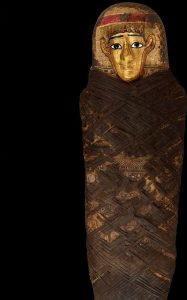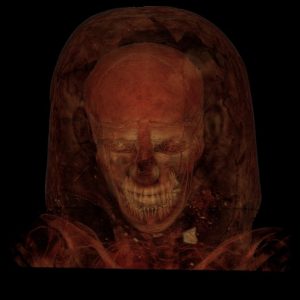
Certainly, the Field Museum is known for its T Rex and dinosaurs in its “Evolving Planet” exhibition and for its native American exhibits including the popular Pawnee Earth Lodge.
But another favorite permanent exhibition is “Inside Ancient Egypt” where visitors descend down into a tomb and see painted mummy coffins.

Now, the contents of those coffins and others can be revealed because of current technology.
“Mummies,” the Field’s newest exhibition doesn’t just display coffins, many of which are gilded. It has wrapped mummies, mummy masks, some CT scans, a CT scanner and ceramics
It also has sculptures and 3D images that show what a mummified person likely looked like when alive.
For instance, there is a mummy of an Egyptian woman in the exhibit from 1,500 years ago that scientists say died when in her 40s, had curly hair and a slight overbite.
Just as fascinating are interactive touch-table stations where visitors see artifacts and mummies the way scientists do.

“This exhibition allows visitors to see how we use modern technologies to learn about the lives of ancient peoples and cultures,” said Curator Bill Parkinson.
“Before, you would have to unwrap the mummy, or even cut it open, to learn more about it. Now we can use non-destructive methods to learn so much more about the past,” Parkinson said.
Also featured, is Peruvian mummification done by the Andean cultures earlier than in Egypt.
“One of the unique things about this exhibition is the inclusion of the Peruvian mummification traditions, which started much earlier than in Egypt and lasted until the Spanish conquest 500 years ago,” said Curator Ryan Williams. “That seven thousand year history of Andean mummification is something most people have never heard previously.”

“Mummies,” up now through April 21, was developed as a traveling exhibit by the Field Museum but has just returned home.
“Because the exhibition is back at its home base, we’ll be able to include some cool artifacts that were too fragile to send out on the road,” said Exhibitions Project Manager Janet Hong.
Thus, a couple of two-and-a-half-foot tall Peruvian beer jars, once shown at Chicago’s 1893 World’s Fair, were added to the exhibit.
Mummies is a ticketed exhibition. A Good way to see it and such exhibits available through General Admission such as “Inside Ancient Egypt” is with a Discovery or All-Access pass.
The Field Museum is at 1400 S. Lake Shore Drive, Chicago. Hours: Daily 9 .am. to 5 p.m. except Christmas. For tickets and more information call (312) 922-9410 and visit Field Museum.
Jodie Jacobs
All photo have copyrights
